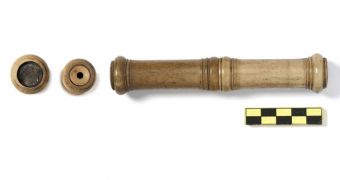Investigators have recently discovered five unusual telescopes in Amsterdam, the Netherlands. The instruments, 3 to 5 inches long (80 to 140 millimeters), were fashioned out of cattle metatarsal bones, and were once thought to be a luxury item.
Five such instruments were discovered, and all were determined to date back to the 18th Century, a time when the city was extremely prosperous, a center of global trade, and a Mecca for artisans, craftsmen, artists and so on.
Experts on such instruments believe that the bone telescopes were not used primarily for astronomical observations, but rather for gazing at faraway objects on land and sea. The telescopes were most likely used exclusively by the social elites of the time.
What is especially interesting is the type of material used to create them. “This particular bone of cow, the metatarsal bone, is actually quite straight and round. It's a nice shape to make these telescopes from, it's straight and (has a) very round narrow cavity,” Space quotes Marloes Rijkelijkhuizen as saying.
The expert holds an appointment as a researcher with the Amsterdam Archaeological Center at the University of Amsterdam. She believes that each of the telescopes had a pair of lenses, of the same type that Galileo used to observe Jupiter and its four largest moons.
The lens system would have consisted of a convex objective and a concave ocular. Establishing this is a bit difficult, since only two of the artifacts discovered still have their lenses. The longest one has both lenses.
The interesting thing about this particular telescope is that it's made up of two smaller parts, which must be screwed together at the middle. Scientists also found a feature that may be an aperture stop, a small insertion made out of bone that features a small hole.
Each of the telescopes is capable of a 3X magnification, which would have made them exquisitely well-suited for observing opera and theater performances, or for scouting the horizon line while traveling at sea.
The study covering the new discoveries is published in the latest issue of the esteemed Journal of Archaeology in the Low Countries.

 14 DAY TRIAL //
14 DAY TRIAL //